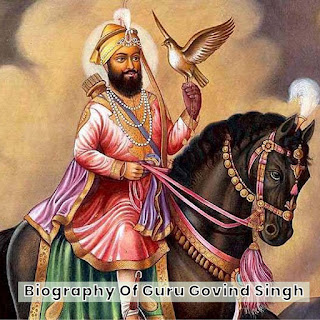Biography of Guru Gobind Singh
Name- Guru Gobind SinghDate of Birth- 22 December 1666Died- 7 October 1708Father’s Name- Guru Tegh BahadurMother’s name- GujariWife name- जीतोNames of sons- Ajit Singh, Jujhar Singh, Zorawar Singh and Fateh Singh
Guru Gobind Singh was the tenth Guru of the Sikhs. After the martyrdom of his father, Shri Guru Tegh Bahadur, he became the 10th Guru on November 11, 1675. He was a great warrior, poet, devotee and spiritual leader. In 1699, on the day of Baisakhi, he founded the Khalsa Panth, which is considered to be the most important day in the history of Sikhs.
Guru Gobind Singh Early Life-
Guru Gobind Singh was born on 22 December 1666 in Patna. His father’s name was Guru Tegh Bahadur and his mother’s name was Gujri. He was named Gobind Rai at birth, he was the only child. His father was the 9th Guru of the Sikhs.
In 1671, Gobind Rai travelled with his family from Danapur and started receiving his basic education on the journey itself. He received education in Persian, Sanskrit and martial skills. He and his mother finally joined their father in 1672 at Anandapur where they continued their further education.
On 11 November 1675, Aurangzeb publicly beheaded his father, Guru Tegh Bahadur, in Chandni Chowk, Delhi, for not accepting Islam himself to save them from forcible conversion after hearing the plea of Kashmiri Pandits. After that, on the day of Vaishakhi, on 29 March 1676, Govind Singh was declared the tenth Guru of the Sikhs.
His education continued even after becoming the 10th Guru. Under education, he learned writing-reading, horse-riding and military skills. In 1684, he composed Chandi Di Vaar. Till 1685 he lived at a place called Paonta on the banks of river Yamuna.
Marriage-
Guru Gobind Singh had three wives. The first marriage took place on June 21, 1677, at the age of 10 with Jeeto at Basantgarh, 10 km from Anandpur. From whom he had 3 sons whose names were Jujhar Singh, Zorawar Singh, Fateh Singh. The second marriage took place on April 4, 1684, at the age of 17 with Mata Sundari in Anandpur. They had a son named Ajit Singh. The third marriage took place on April 15, 1700, at the age of 33 with Mata Sahib Devan. Although he did not have any children, his period on the pages of the Sikh Panth was also very influential.
Establishment of Khalsa Panth-
A collective form of duly initiated followers of Sikhism is called the Khalsa Panth. In 1699, on the day of Baisakhi, he founded the Khalsa Panth, which is considered to be the most important day in the history of Sikhs.
Compositions of Guru Gobind Singh Ji-
- Jaap Sahib: Compilation of attributes of a Nirankar
- Akal Ustat: A great injury on the praise and rituals of the ancient ancestor
- Bachitra Natak: The biography of Gobind Singh and the composition described from the spiritual lineage
- Chandi Charitra – 4 compositions – Praises of Arup-Adi Shakti Chandi. In this, the beliefs believed in Chandi’s body, woman and mother idol have been broken. Chandi is depicted as the power of Parameshwara = order. Composition is based on the Markandeya Purana.
- Zafarnama: Letter to the Mughal Emperor Aurangzeb.
- Khalsa Mahima: Definition of Khalsa and Creation of Khalsa.


Leave a Reply